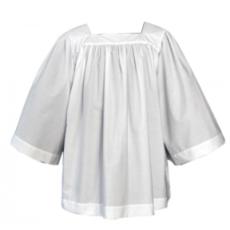

Q. 1. What is the purpose of the Altar server surplice?
A. 1. The surplice or overslop (Late Latin superpelliceum, from super, "over" and pellis, "fur") is a liturgical vestment of the Western Church. It is in the form of a tunic of white linen or cotton fabric, reaching to the waist or to the ankles, with wide or moderately wide sleeves. It usually features lace decoration and may have embroidered borders.
The surplice is worn over the cassock by clergy and choristers during liturgical services.
The surplice is meant to be a miniature alb, the alb itself being the symbol of the white garment received at Baptism. As such, it is appropriately worn by any cleric, by lectors and acolytes, or indeed by altar servers who are technically standing in for instituted acolytes for any liturgical service. It is often worn, for instance, by seminarians when attending Mass and by non-clerical choirs. It is usually worn over a cassock and never alone, nor is it ever gathered by a belt or cincture.
The surplice may be worn under a stole by deacons and priests for liturgical ceremonies or the celebration of Sacraments outside of the Mass. On occasion, a cope is worn over the cassock, surplice and stole.
As part of the choir dress of the clergy, it is normally not worn by prelates (the pope, cardinals, bishops, monsignori, and some canons) - instead, these clerics wear the rochet, which is in fact a variant of the surplice.
The surplice belongs to the vestes sacrae (sacred vestments), though it requires no benediction before it is worn. [Source: https://en.wikipedia.org/wiki/Surplice]
The Altar Server Surplice
Why do Altar servers have to wear a surplice over their cassock? The cassock is a clerical garb. Altar servers, boys only prior to Vatican II, both genders since Vatican II, are not priests or deacons. The surplice distinguishes the server in the Church from the priest who would normally wear his cassock and Roman collar without a surplice.
Since the 1970's, Church suppliers have been pushing the sale of albs to replace cassocks because it is a symbol of baptism according to them. Some parishes determined that girls looked out of place in a cassock and surplice, therefore requiring them to wear albs with a cincture. Consequently this made the girls look more clerical while the boys had the appearance of being servers.
Some parishes have invested a lot of money to have all their servers, boys and girls, wear albs. When dealing with adult servers who are wearing albs, you cannot tell them apart for the members of the clergy.
During the past 20 years, many Dioceses have returned to the wearing of cassocks and surplices for Altar servers. Consequently, negative comments are heard from members (male and female) of the congregation who state, "I find girls in cassock and surplice repulsive since cassock and surplice are clerical garb and the clerical state is reserved to men. "Ecclesiastical cross-dressing" I heard it referred to as once. If they want to continue using female altar servers, they ought to dress them in something more suitable, like a choir robe."
While it appears that the male Altar server surplice is here to stay, the future of female Altar servers remains a mystery. Maybe the female Altar server fad will pass away in time.